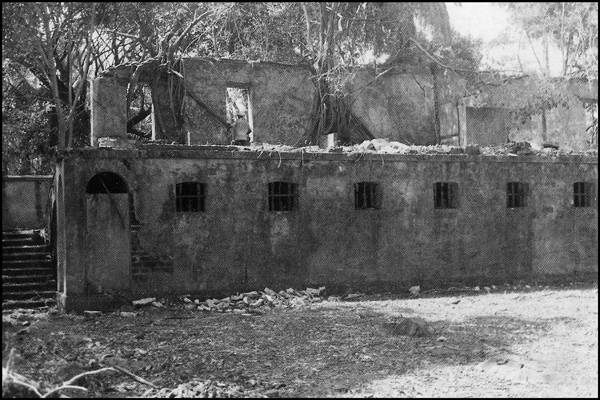
Prisoner cell block
I remember the very first full-length book I read. I might have been seven or eight years old and I was abed with a fever when I read Smilin’ Jack Escapes from Devil’s Island. I still remember his description of building a glider and departure from a cliff top, maybe the same one that Papillion escaped from.) That fever must have stoked my imagination. I was hooked on books from the day I turned the last page of that book and regretted that it was over.
I thought of Smilin’ Jack as I trudged up the slope of the real Devil’s Island, a place I never thought I would visit when I was a kid. The first thing learned was that Devil’s Island is really three islands, Les Iles du Salut, that are clustered twelve miles off the coast of French Guyana and that different features of the prison system that was maintained by the French from 1851 to 1953, were spread over all three of them. My visit was only to the main island, L’Ile Royale, where most of the thousand or so prisoners were kept and most of the ancillary structures, such as the hospital, chapel, warders quarters and morgue, in addition to the main cellblock, still remain.
My second book about the Island was Papillon, the story of and by Henri Charrière, who escaped from there around 1948, seventeen years after being sent there. It was made into a movie in 1973 starring Steve McQueen and Dustin Hoffman. At the summit of the island, I see there is perhaps a place from where Jack and Papillon (for the butterfly tattoo n his chest) might have made their daring departures. But then, the solitary confinement block is over on the Ile St. Joseph. In the movie, there is quite a high cliff, which there indeed might be over on the Ile St. Joseph, where the solitary confinement cells are. One can see why very few men escaped from Devil’s Island; the nearest land was a twelve-mile shark gauntlet away.
Also, very few were ever repatriated to France. But one of those was the renowned Captain Alfred Dreyfus. L’affaire Dreyfus was the subject of the second book I read hat involved Devil’s Island. France was nearly sundered by the framing of Captain Dreyfus for treason, and the anti-Semitism was that also a divisive element of his case. Dreyfus ended up doing four years in Devil’s Island (literally, in his case, because he was kept under close guard in a separate house on the one island that is named L’Ile du Diable. After he was exonerated with the help of the likes of Emile Zola (his famous 1898 letter on the front page of the Paris daily, L’Aurore, titled in huge print, “J’Accuse!” in which he accuses the French government of anti-Semitism and falsely incarcerating Dreyfus), Dreyfus was one of the few to make it off Devil’s Island and be repatriated.
Dreyfus was fortunate. He was, at times, required to sleep in irons for a time, but otherwise was reasonably comfortable in a hut that was four meters by four meters. The cells for other prisoners, most of which were in a cell block that still exists, were less commodious and were caged at the top so that they could be under constant surveillance. The worst incarceration was a smaller cellblock that held those who were scheduled for execution. Yet, the colony contained its more humane elements, a hospital (and lunatic asylum), a chapel, and even a swimming area composed of a sectioned-off area of beach. There are also a couple of cemeteries, but these seem to have been reserved for the staff. Convicts were wrapped in a shroud, placed in a coffin weighed with a few stones and dropped from a boat into the sea.
Today, the colony strikes one as a place gradually going to ruin, with some buildings improved and retained for the tourist trade. Only the cells convey a sense of the suffering that the inmates might have undergone, particularly if they were transported to this place for crimes that today would result in a slap on the wrist, like that for which Victor Hugo wrote that Jean Valjean was convicted for committing. French indictees were required to prove their innocence, rather than vice versa. Still, there were probably proportionally far fewer Frenchmen and women in prison than the one in one-hundred in America today. There is a leavening of Devil’s Island today as the tropical island flora and fauna gradually reassert their hegemony over the three islands. Agoutis, lizards, iguanas, and peacocks scurry and wander among the crumbling buildings and coconuts can be seen sprouting new palms. Devil’s Island looks almost like the type of place some oil sheik would buy and turn into some private pleasure domain; but then, superstition and the ghosts of the past, the desperate screams in the humid tropical nights or the threat of malaria, and yellow and dengue fevers might keep them at bay.
My fever wasn’t malaria, yellow, or dengue when a sweated and shivered and turned the pages of Smilin’ Jack Escapes from Desert Island. But it cooked my young imagination and gave me a thirst for more adventures from books, and left me with the desire to see the places that inspired them. And, thanks to Smilin’ Jack, I smiled to myself, knowing that I was probably the only one on Devil’s Island that day who knew how to build a glider and make my escape.
___________________________________
©2008, James A. Clapp (UrbisMedia Ltd. Pub. 2.28.2008)
